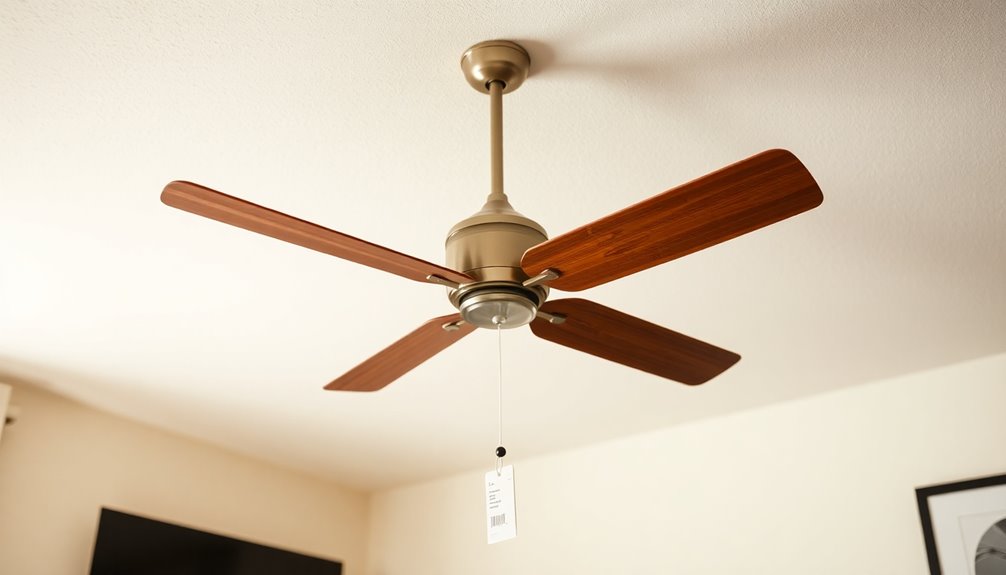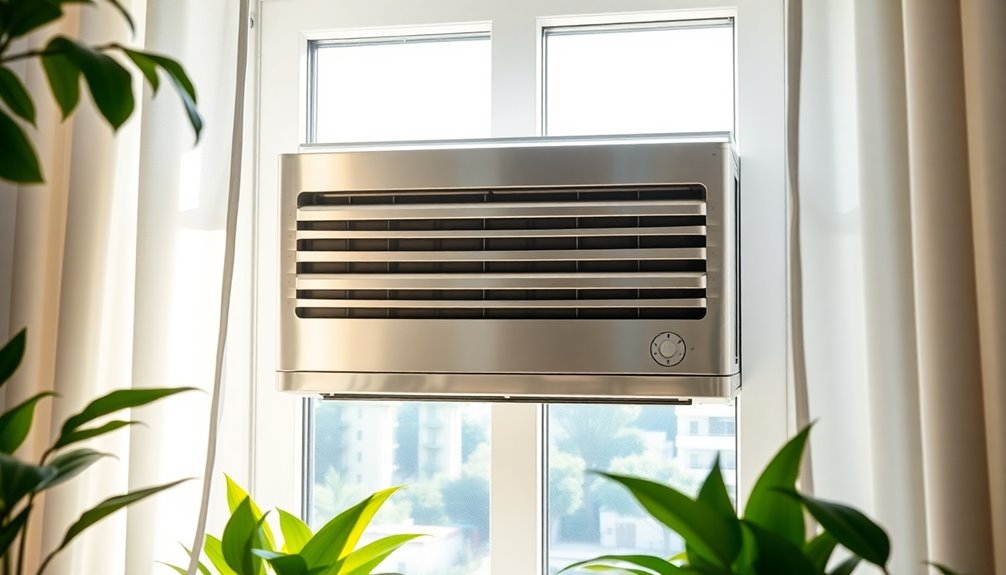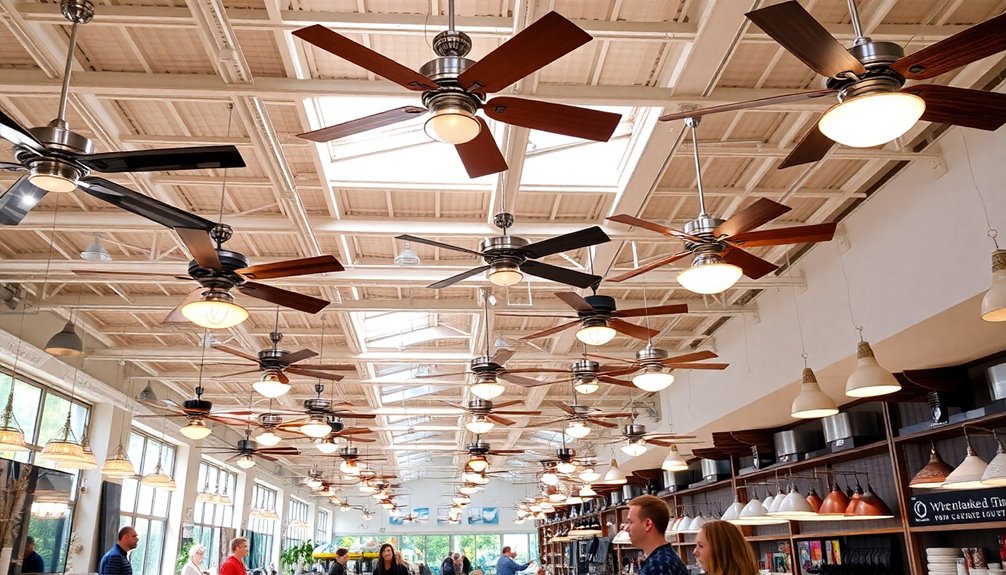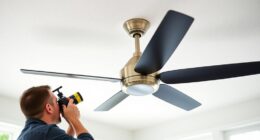Ceiling fans typically range from $50 to $1,400, depending on the size and features you choose. Most mid-range models fall between $150 and $350. Keep in mind that installation costs average around $248, which can push your total expenses to between $250 and $700. If you opt for additional features like remote controls or lights, expect to add another $100 to $300. Whether you want a standard model or a stylish high-end fan, knowing these costs helps you budget. You'll discover more factors that can influence your ceiling fan expenses if you explore further.
Key Takeaways
- Ceiling fan prices range from $50 to $1,400, depending on size, style, and features.
- Average installation costs are around $248, with total expenses between $250 and $700.
- Mid-range ceiling fans typically cost between $150 and $350.
- Additional features like lights or remotes can add $100 to $300 to the overall cost.
- DIY installations can save $50 to $200 on labor, while professional help averages about $248.
Cost Overview of Ceiling Fans

When it comes to ceiling fans, understanding the cost can help you make an informed decision. Ceiling fans cost typically ranges from $50 to $1,400, depending on size, style, and features. If you're looking for a mid-range fan, expect average costs between $150 and $350.
Installation costs also play a significant role in your total cost. For basic setups with existing wiring, installation costs generally range from $100 to $500. However, if you need new wiring, that can push your ceiling fan installation cost up to $2,000.
On average, you'll find the average cost to install a ceiling fan is around $248. When you combine this with the fan price, your total installation costs will likely fall between $250 and $700, especially if new wiring is involved.
Keep in mind that additional features like built-in lights or remote controls can add anywhere from $100 to $300 to your overall expenses. Finally, remember that factors affecting labor costs, like seasonal pricing fluctuations and local rates, can also influence your final bill, so it's wise to gather quotes before deciding.
Factors Affecting Installation Costs

Several factors can influence the installation costs of ceiling fans, and it's important to take them into account before making a decision.
First, labor rates vary greatly, typically ranging from $50 to $200 depending on your location and whether you hire a professional electrician or a handyperson.
Next, wiring requirements play an essential role; basic setups might cost between $100 to $500, while new wiring installations can escalate to as much as $2,000.
Additionally, if you want features like separate switches for lights and fans, expect to add another $100 to $200 to your total.
Access issues can further complicate matters—if your ceilings are high or if the installation site is challenging to reach, the labor and material costs will rise.
Finally, consider the number of fans you're installing. Scheduling multiple installations at once can reduce your overall ceiling fan costs by minimizing travel fees and lowering hourly contractor rates.
Types of Ceiling Fans

Exploring the various types of ceiling fans can help you find the perfect fit for your space and needs. Here's a quick overview of some popular options:
| Type of Ceiling Fan | Price Range |
|---|---|
| Standard Ceiling Fan | $50 – $300 |
| Low-Profile Ceiling Fans | $50 – $300 |
| Hanging Propeller Fans | $150 – $550 (install) |
| Directional Ceiling Fans | $150 – $800 (install) |
| High-End Rotational Fans | $200 – $1,500 |
Standard ceiling fans are versatile and commonly found in many homes. If you have low ceilings, low-profile ceiling fans are an ideal choice. For spaces with high ceilings, consider hanging propeller fans, which enhance airflow without overwhelming the room. Directional ceiling fans offer adjustable airflow, making them perfect for specific cooling needs. Finally, high-end rotational fans bring style and powerful functionality, but they come at a higher price point.
When considering the types of ceiling fans, think about your room size, ceiling height, and budget. This way, you can choose the fan that best suits your needs.
Installation Process

Before starting the installation process, you need to assess your existing wiring and verify your ceiling can handle the fan's weight.
Don't forget to prioritize safety by turning off the power and using a sturdy ladder.
These steps will set you up for a successful and efficient installation.
Pre-installation Assessment Steps
Evaluating your space is vital before installing a ceiling fan. Start with a pre-installation evaluation of the existing wiring to guarantee it's compatible with your new fan. Check local safety codes to confirm it meets standards.
Next, measure your ceiling height and room size to determine the appropriate fan size. For rooms under 75 sq. ft., a 29-36 inch fan is recommended, while spaces up to 350 sq. ft. should use a 52-56 inch fan.
It's important to verify that the ceiling box supports a ceiling fan. If it's not rated for this purpose, you'll need to purchase a fan-rated junction box and possibly a fan brace for additional support.
Also, check that the installation location provides at least 18 inches of clearance from the blades to walls or obstructions.
Lastly, consider any additional needs, such as new wiring or switches. These factors can greatly affect your installation costs, which typically range from $100 to $500 for basic setups.
Installation Safety Precautions
Once you've assessed your space and confirmed that everything is in order, it's time to focus on safety precautions during the installation process.
First and foremost, always turn off the power at the circuit breaker to prevent electrical shock. This step is vital before you start any wiring.
Next, use a sturdy ladder to safely reach the ceiling. Confirm it's positioned on a flat surface to maintain stability during installation.
You'll also want to verify that the existing ceiling box is rated for ceiling fan support. If it isn't, install a fan-rated junction box and brace for added security.
Don't forget to wear appropriate safety gear, like goggles and gloves, to protect yourself from debris and sharp edges.
It's important to follow the manufacturer's instructions closely and check local building codes to guarantee compliance and safety during the installation.
If you're unsure about any step, consider hiring a licensed electrician for assistance.
Taking these precautions will help guarantee a smooth and safe installation process for your ceiling fan.
DIY vs. Professional Installation

When deciding between DIY and professional installation for your ceiling fan, consider the cost and complexity involved.
While you might save money with a DIY approach, it's essential to assess your electrical skills and the local codes to avoid future expenses.
Professional installation offers peace of mind, ensuring safety and compliance, especially for more intricate setups. Additionally, hiring a professional can help prevent issues similar to toilet maintenance problems that arise from improper installation.
Cost Comparison Analysis
Considering the potential savings, many homeowners weigh the pros and cons of DIY installation versus hiring a professional for ceiling fan setups.
If you choose the DIY route, you could save $50 to $200 on labor costs, with total expenses ranging from $100 to $275 for materials and your time spent learning.
However, if you opt for professional installation, you can expect average costs around $248, with labor costs between $50 and $200.
Basic installations using existing wiring typically range from $100 to $500, while new wiring can push costs up to $2,000, making hiring a pro more appealing for complex setups.
Professionals usually complete installations in 1-2 hours for basic setups, ensuring compliance with safety codes and proper wiring, which can be essential for your safety.
On the other hand, if you decide to tackle it yourself, be prepared for potential complications, especially if you're inexperienced.
Additional features like remote controls or multiple fan installations can complicate DIY expenses further.
Ultimately, weighing these factors will help you decide between DIY vs. professional installation for your ceiling fan.
Installation Complexity Factors
The complexity of your ceiling fan installation can greatly influence whether you tackle it yourself or hire a professional. If your setup is straightforward and relies on existing wiring, you might consider DIY ceiling fan installations. This can save you between $50 to $200 on installation labor, but don't forget to factor in potential learning curves and materials, which can push your total costs to between $100 and $275.
However, if you're dealing with a complex ceiling or need new wiring, professional installation is often the best route. This typically costs between $100 and $500, depending on the fan type and the complexity of the job. A licensed electrician can usually complete basic installations in 1-2 hours, but more intricate setups might take 3-4 hours.
If you're simply replacing a fan with existing wiring, hiring a handyperson for about $60 can be a budget-friendly alternative to professional electricians. But remember, using a licensed electrician for significant wiring changes isn't just about convenience; it guarantees compliance with local codes and enhances safety.
Choose wisely based on your specific installation needs.
Safety and Compliance Issues
Safety is an essential factor to weigh when deciding between DIY and professional ceiling fan installation. While DIY installations may seem cost-effective, they can lead to significant safety hazards if not executed properly.
If your installation doesn't comply with local building codes, you could face fines or worse—electrical hazards like fires or equipment failure. Regular maintenance of electrical components is crucial to prevent these issues, as neglect can lead to costly repairs down the line.
Hiring a licensed electrician for professional installation guarantees that your ceiling fan is set up according to safety standards and local regulations. This is especially important for new wiring or complex setups that require expertise.
While a basic ceiling fan installation might take 1-2 hours, more complicated jobs can extend to 3-4 hours, emphasizing the value of professional knowledge. Furthermore, many ceiling fans come with integrated lighting options, making professional installation even more critical to ensure safety and functionality.
Before attempting any DIY installations, it's essential to check your local building codes. Non-compliance can lead to dangerous situations, negating any savings from doing it yourself.
Ultimately, investing in professional installation not only safeguards your home but also provides peace of mind, knowing that everything is done right and safe.
Cost-Saving Tips

When you're looking to save money on ceiling fan installations, a few smart strategies can make a big difference. One of the best cost-saving tips is to install multiple ceiling fans at the same time. Contractors often lower their hourly rates for larger ceiling fan installation jobs, which can considerably cut your materials and labor costs.
If you're replacing a ceiling fan, consider doing it in areas that already have wiring. This approach can save you between $100 and $500 on installation costs compared to installing new wiring.
Additionally, purchasing ceiling fans during off-peak seasons might lead to discounts on both the fans and installation services, letting you stretch your budget further.
Don't forget to look for ENERGY STAR-rated ceiling fans. They not only help you save money upfront but can also reduce your energy costs by up to 30% in the long run.
Finally, if you're carrying out a straightforward ceiling fan installation job, hiring a handyperson instead of a licensed electrician can save you between $50 and $200. By following these tips, you can make your ceiling fan project more affordable.
Seasonal Price Fluctuations

Maneuvering through the seasonal price fluctuations of ceiling fans can lead to significant savings for savvy shoppers. If you time your purchase right, you could score a ceiling fan at a reduced cost. Prices often dip by 20% to 40% during major holiday sales, particularly around Memorial Day and Labor Day. While summer sees a spike in demand, it's also when retailers push promotions. However, as autumn approaches, you might find better deals as prices stabilize or drop. Additionally, just as with home security systems, timing your purchase can greatly affect your overall savings.
Here's a quick look at the seasonal trends:
| Season | Price Change |
|---|---|
| Late Fall/Winter | 20% – 40% off |
| Spring | Steady Prices |
| Summer | High Demand, Promotions |
| Early Fall | Stabilizing Prices |
| Installation | Competitive Rates
Additional Accessories and Features

Investing in additional accessories and features for your ceiling fan can greatly enhance its functionality and convenience.
For instance, adding a remote control can typically range from $50 to $100, allowing you to adjust settings without getting up. If you want separate control for lights and fans, be prepared to add between $100 and $200 to your installation cost.
Downrods are another essential accessory, helping you adjust the fan height for ideal airflow. Depending on the length and material, these can cost anywhere from $5 to $100.
Integrated lighting features in ceiling fans usually bump up the total cost by about $100 to $300, providing both illumination and airflow in one unit.
While Energy Star-rated ceiling fans might be pricier initially, they can lead to significant savings on utility bills, reducing energy consumption by up to 30%.
Understanding Labor Rates

Choosing the right ceiling fan is just one part of the equation; understanding labor rates for installation is equally important. Labor rates can vary widely based on whether you hire a local handyperson or a professional electrician. Typically, basic installation by a handyperson costs around $60, while a licensed electrician's services can range from $100 to $200.
Your geographic location plays a significant role in determining these rates. If you live in an urban area, expect higher labor costs compared to rural regions.
Additionally, installation complexity can affect overall labor costs. If there are access issues or if the installation requires special handling, you might face increased charges due to the extra time and effort involved.
If you're planning to install multiple ceiling fans, you can save money by minimizing travel fees and taking advantage of bulk pricing.
Importance of Proper Support

When you install a ceiling fan, proper support is essential for safety and functionality.
You need to guarantee your ceiling box is rated for fan use to handle the weight and movement of the fan.
Following installation safety standards not only protects your investment but also prevents potential hazards.
Ceiling Box Support
Proper support for a ceiling fan is important to guarantee safety and functionality. When you're planning your ceiling fan installation, it's essential to use ceiling box support that can handle the weight and forces involved.
Standard ceiling boxes often fall short, so you should opt for fan-rated junction boxes and braces designed specifically for ceiling fans. This choice guarantees that your fan is securely mounted, adhering to the National Electrical Code (NEC) standards.
Installing a ceiling fan without proper support can lead to serious safety hazards, including the risk of the fan falling. This not only endangers lives but can also cause substantial damage to your property.
By investing in a fan-rated ceiling box, typically priced between $15 to $50, you're making a small investment that can save you from the costs associated with improper installation and potential accidents.
Installation Safety Standards
Installing a ceiling fan without adhering to safety standards can lead to serious consequences. Proper support is essential to guarantee your fan installation job is safe and effective. As a ceiling fan installer, you must use fan-rated junction boxes and secure the fan with adequate support brackets. The National Electrical Code (NEC) requires that ceiling fans be supported by a brace capable of holding at least 50 pounds. This prevents safety hazards like falling fans.
| Safety Standard | Importance |
|---|---|
| Fan-rated junction boxes | Designed to handle weight and motion |
| Support brackets | Provide additional stability |
| Regular inspections | Identify wear and address issues promptly |
Always adhere to local building codes to enhance safety and avoid costly repairs or liability issues. Regular inspections of your ceiling fan support system are essential; any signs of wear or loosening should be addressed immediately. By taking these precautions, you guarantee your ceiling fan remains securely in place, providing comfort without compromising safety.
Weight and Load Capacity
Guaranteeing your ceiling fan has the right support is vital to its safe and efficient operation. The average ceiling fan weighs between 10 to 50 pounds, so having proper weight and load capacity is fundamental. Without adequate fan support, you risk structural damage and potential accidents.
To prevent these issues, make certain to:
- Use a fan-rated junction box that can handle at least 50 pounds.
- Install a sturdy fan brace for extra support.
- Follow local building codes that dictate specific support requirements.
Neglecting these aspects not only affects the performance of your fan but could also lead to costly repairs or replacements down the line.
Regular inspections of the fan's mounting and support system are critical, especially in high-usage areas. These checks guarantee ongoing stability and safety, helping you avoid the potential costs associated with improper installation.
Frequently Asked Questions
How Much Should a Good Ceiling Fan Cost?
When you're looking for a good ceiling fan, expect to spend between $50 and $300, depending on what you want.
If you're after mid-range models, which often include features like remote controls, you might pay between $100 and $300.
For high-end fans with unique designs, the price can start at $300 and go much higher.
Don't forget to factor in installation costs, as they can add another $100 to $500 to your total.
How Much Does It Cost to Get Ceiling Fans?
Imagine a breeze dancing through your home, bringing comfort and style.
When you're considering ceiling fans, think about your budget. Installation typically adds $144 to $353 to your overall costs, depending on complexity.
Fan prices can range from $50 to $1,400, influenced by size and features. If you're hiring an electrician, expect to pay $50 to $200 per hour for their expertise.
Is It Expensive to Run a Ceiling Fan 24 7?
Running a ceiling fan 24/7 isn't that expensive.
It typically costs you about $0.01 to $0.02 per hour, adding up to around $7.20 to $14.40 monthly, depending on your fan's wattage and local electricity rates.
With energy-efficient models using as little as 30 watts, you'll keep your energy bills low.
Plus, the wind-chill effect lets you raise your thermostat setting, leading to even more savings on cooling costs.
Is Using a Ceiling Fan Cheaper Than AC?
Using a ceiling fan is definitely cheaper than running an air conditioning unit.
Ceiling fans consume much less electricity, costing you around $5 to $15 monthly, while AC can spike your bills to $100 or more. Ceiling fans are an energy-efficient option for staying comfortable, as they use significantly less power compared to air conditioning systems. By circulating air effectively, they help create a cooling sensation, allowing you to raise your thermostat setting and save even more on energy costs. For those wondering, “do ceiling fans increase electricity use,” the answer is yes, but the impact is minimal compared to the substantial energy consumption of an AC unit.
Plus, ceiling fans help lower perceived temperatures, allowing you to raise your thermostat setting, which can save you even more on cooling costs.
Conclusion
In the end, finding the right ceiling fan is like discovering a hidden treasure; it brightens your space and keeps you cool. By understanding the costs and factors involved, you're not just investing in a fan but in your comfort and style. Whether you choose to install it yourself or call in a pro, your choice can make all the difference. So, take a moment to weigh your options and let your ceiling fan elevate your home.









